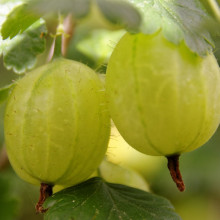Katie asked the very seasonal question of "Why is gooseberry jam red, when gooseberries are green?". This really baffled the Naked Scientists, so Joanna Kerr put this thorny question to Dr Sarka Tumova, a food scientist at the University of Leeds.
In this episode

Why is gooseberry jam red when gooseberries are green?
Charis Lestrange put this thorny question to Dr Sarka Tumova, a food scientist at the University of Leeds.
Sarka - This question also really intrigued me. My mother often makes jam from green gooseberries and the colour is never red but rather dark yellow or light orange. It's a colour change either way.
Charis - We also had a mixed response on Facebook. Jodi Knight thinks it's just the difference in the colour of gooseberry used. Mike Sharp asked, "what even is a gooseberry?" Well, a gooseberry is a round fruit with translucent hairy skin which according to Ndileka is spooky. But why would green fruit give rise to red coloured jam?
Sarka - The answer as to why this happens is not so straightforward. To put it simply, it is the original fruit colour and changes in conditions during the process of jam making. When you make a jam, you mix sugar and fruit, pectin and a source of acidity and heat it until gelling process starts.
Charis - I've always heard of the word pectin but what actually is it?
Sarka - Pectin is a plant polysaccharide or a type of long sugar which is important in plant growth and defence against disease or parasites. Luckily, for food lovers, it also happens to be a very good gelling agent which can turn a mix of sugar and fruit into a tasty treat. Some fruits like gooseberries have a lot of pectin, but some need to have pectin added when you make jam from them.
Charis - But this pectin gelling agent wouldn't give it a colour, would it?
Sarka - No, but gooseberries also contain pigments called anthocyanins and it is these colours that make fruits like cherries red or blueberries blue. Interestingly, they are known to change colour when in different acidities or when they are heated and breakdown into smaller pieces.
Charis - I see. It's the mixture of the change in acidity and these pigments. But when I make jam, I don't change the acidity or at least not on purpose anyway.
Sarka - Actually, you might. If you're adding lemon juice, which is done for some fruits that don't have enough acidity but not for gooseberries as they're sour enough on their own. In this case, I think it's rather the fact that during cooking anthocyanins come into contact with other pigments, pectin or any metal ion which may be leeched from the cookware. This makes the new combination to the different colour and in this case, it's red or dark pink. There could also be other effects from heating the jam when more complex pigments get broken down to smaller pieces with different colour.
Charis - This explains why the colour changes but why doesn't it change colour every time?
Sarka - This could be down to differences in the exact composition of anthocyanins or maybe other pigments in the fruit which is known to depend on the fruit variety, ripeness or properties of soil in which the gooseberries were grown. But my personal favourite explanation is the type of pan which could lead to the right composition of metal ions.
Charis - I hope this has given you some food for thought the next time you go gooseberry picking. Next week, we'll be answering this question that has been sent in by Anders.
Anders - Why do power lines make so much noise?
- Previous Gelsemine : Chemistry in its element
- Next Should we drink wee?









Comments
Good site!
Good site!
Add a comment